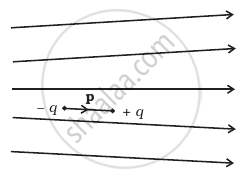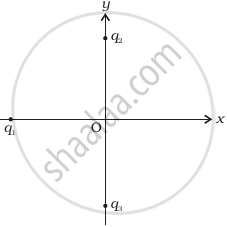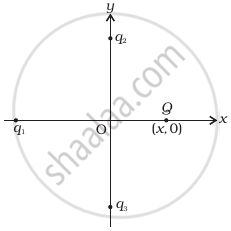Advertisements
Advertisements
प्रश्न
The magnitude of the electric field due to a point charge object at a distance of 4.0 m is 9 N/C. From the same charged object the electric field of magnitude, 16 N/C will be at a distance of ______.
विकल्प
1 m
2 m
3 m
6 m
उत्तर
The magnitude of the electric field due to a point charge object at a distance of 4.0 m is 9 N/C. From the same charged object the electric field of magnitude, 16 N/C will be at a distance of 3 m.
Explanation:
We know that,
E = `(kq)/r^2`
Where E is the magnitude of the electric field, k is constant, q is a charge of magnitude and r is the distance away from the point charge.
Given: E1 = 9 N/C, r1 = 4 and k = `9 xx 10^9` Nm2/C2, E2 = 16 N/C and q is same for both objects.
To find: r2
`E_1 = (kq)/r_1^2`
`9 = ((9 xx 10^9 xx q))/4^2`
`q = ((9 xx 16))/((9 xx 10^9))`
q = 16 × 10-9
`E_2 = (kq)/r_2^2`
`16 = ((9 xx 10^9 xx 16 xx 10^-9))/r_2^2`
`r_2^2 = 9`
`r_2 = 3` m
संबंधित प्रश्न
Why do the electrostatic field lines not form closed loops?
Why do the electric field lines never cross each other?
- An electrostatic field line is a continuous curve. That is, a field line cannot have sudden breaks. Why not?
- Explain why two field lines never cross each other at any point?
A point charge (+Q) is kept in the vicinity of an uncharged conducting plate. Sketch the electric field lines between the charge and the plate?
Explain why two field lines never cross each other at any point?
A point positive charge is brought near an isolated conducting sphere (figure). The electric field is best given by ______.
Figure shows electric field lines in which an electric dipole P is placed as shown. Which of the following statements is correct?

In figure, two positive charges q2 and q3 fixed along the y axis, exert a net electric force in the + x direction on a charge q1 fixed along the x-axis. If a positive charge Q is added at (x, 0), the force on q1
 (a) |
 (b) |
